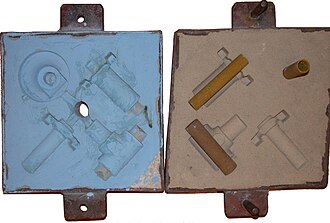Metalworking
Metalworking is the process of working with metals to create individual parts, assemblies, or large-scale structures. The term covers a wide range of work from large ships and bridges to precise engine parts and delicate jewelry. It therefore includes a correspondingly wide range of skills, processes, and tools. Metalworking is a science, art, hobby, industry, and trade. Its historical roots span cultures, civilizations, and millennia.
Metalworking has evolved from the discovery of smelting various ores, producing malleable and ductile metal useful for tools and adornments. Modern metalworking processes, though diverse and specialized, can be categorized as forming, cutting, or joining processes. Today's machine shop includes a number of machine tools capable of creating a precise, useful workpiece.
History
The history of metalworking dates back to the dawn of civilization. The discovery of copper and its alloys marked the end of the Stone Age and the beginning of the Bronze Age. Early metalworking involved smelting to extract metal from ores, followed by forging and casting to shape the metal. The development of iron smelting technology around 1200 BC marked the start of the Iron Age, leading to significant advancements in tools and weaponry.
Processes
Casting
Casting is a process by which a liquid metal is somehow delivered into a mold that contains a hollow cavity of the desired shape and then allowed to solidify. The solidified part is also known as a casting, which is ejected or broken out of the mold to complete the process.
Forming
Forming processes involve shaping metal materials by deforming them in some way without removing material. Techniques include rolling, forging, extrusion, and drawing.
Cutting
Cutting processes involve removing material to shape the workpiece into the desired form. This can be achieved through various methods such as milling, turning, and grinding.
Joining
Joining methods include welding, brazing, soldering, and riveting, which are used to assemble metal parts together to create a final product.
Finishing
Finishing processes are used to improve the appearance, surface texture, or corrosion resistance of a metal workpiece. Techniques include polishing, plating, coating, and painting.
Tools and Equipment
Metalworking requires a variety of tools and equipment, ranging from simple hand tools to complex CNC (Computer Numerical Control) machinery. Hand tools include hammers, chisels, and files, while machine tools cover lathes, mills, and drills. Advanced manufacturing techniques such as laser cutting and waterjet cutting are also used in metalworking.
Safety
Safety in metalworking is paramount, as the processes often involve hot materials, sharp tools, and heavy machinery. Proper protective gear such as gloves, goggles, and ear protection is essential to prevent injuries.
Modern Developments
Advancements in technology have greatly influenced metalworking, with digital technologies such as 3D printing and CNC machining revolutionizing the field. These technologies allow for more precise, efficient, and complex metal parts to be manufactured than ever before.
Conclusion
Metalworking is a crucial industry that supports various sectors including construction, automotive, aerospace, and jewelry. Its rich history and continuous innovation make it a fascinating and vital field of study and work.
| This article is a stub. You can help WikiMD by registering to expand it. |
Transform your life with W8MD's budget GLP-1 injections from $125.
W8MD offers a medical weight loss program to lose weight in Philadelphia. Our physician-supervised medical weight loss provides:
- Most insurances accepted or discounted self-pay rates. We will obtain insurance prior authorizations if needed.
- Generic GLP1 weight loss injections from $125 for the starting dose.
- Also offer prescription weight loss medications including Phentermine, Qsymia, Diethylpropion, Contrave etc.
NYC weight loss doctor appointments
Start your NYC weight loss journey today at our NYC medical weight loss and Philadelphia medical weight loss clinics.
- Call 718-946-5500 to lose weight in NYC or for medical weight loss in Philadelphia 215-676-2334.
- Tags:NYC medical weight loss, Philadelphia lose weight Zepbound NYC, Budget GLP1 weight loss injections, Wegovy Philadelphia, Wegovy NYC, Philadelphia medical weight loss, Brookly weight loss and Wegovy NYC
|
WikiMD's Wellness Encyclopedia |
| Let Food Be Thy Medicine Medicine Thy Food - Hippocrates |
Medical Disclaimer: WikiMD is not a substitute for professional medical advice. The information on WikiMD is provided as an information resource only, may be incorrect, outdated or misleading, and is not to be used or relied on for any diagnostic or treatment purposes. Please consult your health care provider before making any healthcare decisions or for guidance about a specific medical condition. WikiMD expressly disclaims responsibility, and shall have no liability, for any damages, loss, injury, or liability whatsoever suffered as a result of your reliance on the information contained in this site. By visiting this site you agree to the foregoing terms and conditions, which may from time to time be changed or supplemented by WikiMD. If you do not agree to the foregoing terms and conditions, you should not enter or use this site. See full disclaimer.
Credits:Most images are courtesy of Wikimedia commons, and templates, categories Wikipedia, licensed under CC BY SA or similar.
Contributors: Prab R. Tumpati, MD






